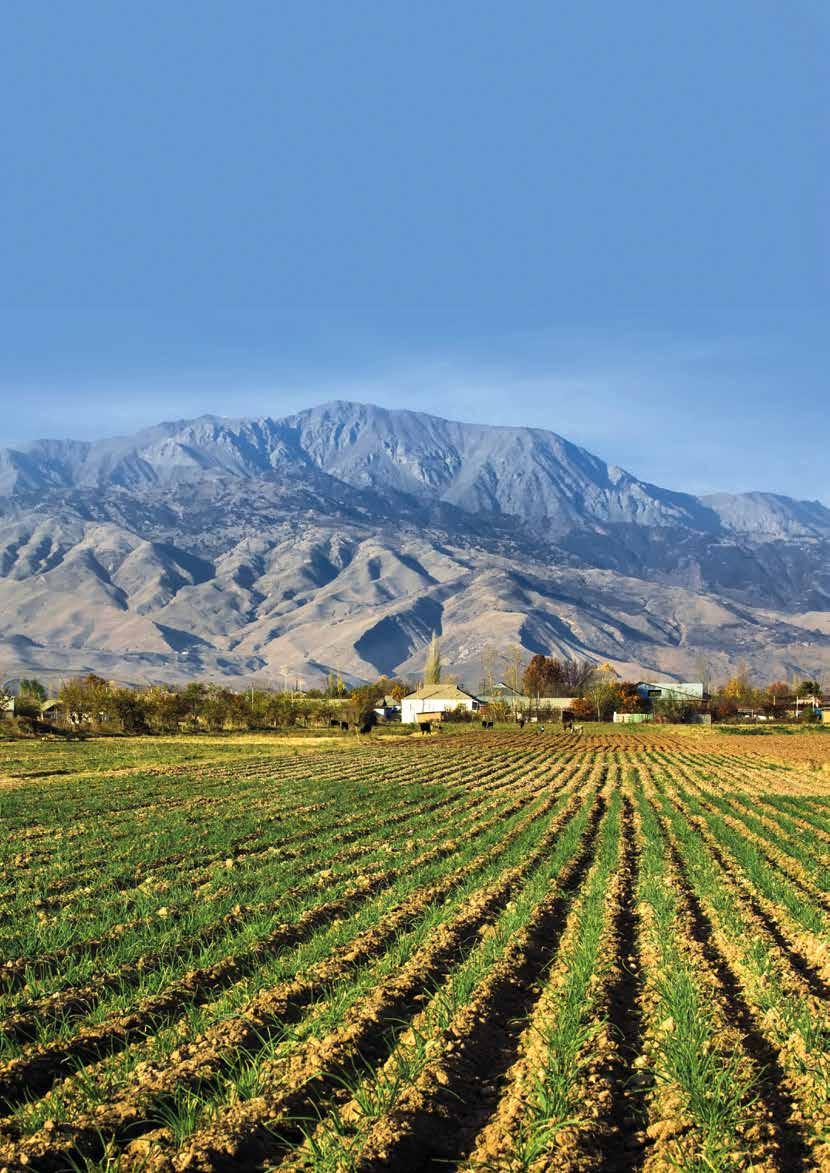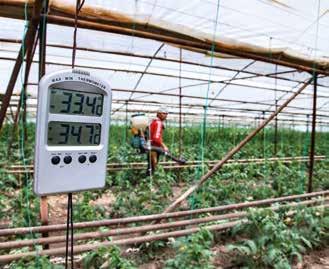About this document: A “seed of inspiration” for climate-resilient agribusiness with multiple benefits for water, energy and food security
The countries of Central Asia increasingly recognise the importance of a multi-sectoral, or “nexus”, approach which aims to simultaneously address sustainability issues on water, energy and land resources in a changing climate and the evolving socio-economic, demographic and geopolitical contexts.
Agribusinesses are in the forefront of climate risks in Central Asia and play a critical role in achieving the region’s food and water security. Some agribusinesses have already invested in resource-efficient, climateresilient technologies. They did it primarily for economic purposes (e.g. to reduce costs and improve quality to enhance their export potential). However, some of those businesses have also actively adapted to their changing business environments to better manage long-term resource security concerns or integrate sustainability principles into their corporate policies. The investment in agribusiness companies have also shown their positive impact on the creation of new markets and jobs
in local communities where they operate, as well as on their supply chains (Figure 1).

This overview document showcases selected examples of good practice in investments in agribusiness in Central Asia, including by farmers, food processing industries, suppliers and logistics companies. These examples highlight the multi-faceted benefits of strengthening resilience of the agricultural sector to increasing water stress and drought risks, while also mitigating negative impacts on the environment.
This document aims also to identify opportunities to scale-up and replicate such innovative approaches across the region. Several barriers still hinder the up-scaling and replication of business models of such “pioneers” in climate-resilient, sustainable agribusiness in Central Asia. Financial institutions and agribusiness companies need enhanced evidence on proven benefits of available technological and financial solutions to
4 | CLIMATE-RESILIENT
IN CENTRAL ASIA
AGRIBUSINESS
promote the nexus approach. Such evidence needs to be compelling and easily understandable to agribusiness companies and their partners, including financial institutions. Agribusiness owners, bankers and government officials also need more capacity to identify, appraise, install and maintain technical solutions to achieve multiple benefits for economic growth, natural resource security and climate resilience. Inadequate policy frameworks also need to be changed to enable interested farmers to embrace the nexus approach in their businesses (e.g. water and energy tariff reforms to incentivise a further intake of resourceefficient technologies and renewable energy).
This overview shows the nexus approach towards competitive and climate-resilient agriculture is not as complex as it may sound. The following four Central Asian case studies provide a “seed of inspiration” for
how agribusiness companies can achieve multi-faceted benefits for local economies and ecosystems, and food and natural resource security:

l A strawberry producer in Turkmenistan has invested in hydroponic greenhouses that have reduced water use by 85%, reduced pesticide use to zero, and expanded growing seasons.
l A food retail company in the Kyrgyz Republic (Kyrgyzstan) has created a market for locally produced lentils that are resilient to climate risks and improve soil fertility. The latter effect also helps farmers reduce the use of fossil fuel-based fertilisers, which contributes to climate change mitigation.
l A sugar producer has triggered a revival of sugar beet production in Kyrgyzstan, adding value to the final product, and contributing to food security, job creation, and more sustainable water and land use in the country.
l “Blended” finance solutions have facilitated agribusiness companies’ access to capital and enhance their knowledge about available technologies in support of climate resilience and sustainable agribusiness practices in Tajikistan.
Water security Improved water resource management through adoption of efficient technologies, recycling practices and reduced pollution through discharges
Energy security
Food security
Environmental security
Economic resilience
Efficient energy use; improved energy dependence; shift to low carbon energy production, including renewables
Increased domestic production and decreased reliance on imports; enhanced resilience of agriculture to climate hazards
Reduced use of pesticides and related pollution; increased production of crop types suited to local environmental and climatic conditions; GHG mitigation by reduced use of fossil fuel-based fertilisers
Higher value products; longer growing period; economic diversification; increasing exports; creating local markets and job opportunities
CLIMATE-RESILIENT AGRIBUSINESS IN CENTRAL ASIA | 5
Figure 1. Positive impacts of agribusiness investments with a nexus focus in Central Asia
Note: The term “agribusiness investments with a nexus focus” is used here to mean those that aim to simultaneously address multiple sustainability issues among water, energy, food, and environmental security as well as economic resilience.
ABOUT THIS DOCUMENT
The development of this overview was inspired and informed by a series of conversations between the Organisation for Economic Co-operation and Development (OECD), the European Bank for Reconstruction and Development (EBRD) and


agribusiness clients of the EBRD. The OECD and the EBRD are part of the consortium implementing a project Water Energy Land-use Linkages: Nexus Solutions for Climate Resilient Central Asia (the Nexus) funded by the Germany’s International Climate Initiative.1


This overview is a starting point. While the analysis here focuses on the selected examples obtained from the EBRD, there are many more such good practices and lessons to be learnt from them across Central Asia. The Nexus project will expand the evidence base on the benefits of climate action through the nexus between energy, water and land use. It will design and operate a financing mechanism to scale up necessary investment.
The project will also develop practical tools and instruments to support reforms in policy frameworks to enable such investment – a critical issue that is not covered in this document. In so doing, the project will help strengthen the resilience of populations and ecosystems in Central Asia to the impacts of climate change, support the countries of Central Asia in enhancing polices that create jobs and economic prosperity, while improving water, energy and land resource security in the region.
6 | CLIMATE-RESILIENT AGRIBUSINESS IN CENTRAL ASIA
ABOUT THIS DOCUMENT
The project will help strengthen the resilience of populations and ecosystems in Central Asia to the impacts of climate change.
Agriculture is a key pillar of the economies of Central Asia.2 The sector accounts for between 5% (Kazakhstan) and 25% (Uzbekistan and Tajikistan) of Gross Domestic Product and between 15% (Kazakhstan) and 46% (Tajikistan) of total employment (World Bank, 2022[1]).
Agribusinesses are in the forefront of climate risks in Central Asia, which include a higherthan-average temperature increase, glacier retreat and associated irrigation water stress and droughts (SIC ICWC & OECD, 2021[2]; Umirbekov, Akhmetov and Gafurov, 2022[3]). The impacts of a changing climate are occurring on top of socio-economic and geopolitical challenges to food, energy and water security in the region. Climate change scenarios for Central Asia predict a considerable increase in average annual temperature (3-7°C for 2071-2100 compared to 1950-2001) (Liu, Liu and Gao, 2020[4]). The impacts of climate change are likely to contribute to more frequent and intense natural hazards (e.g. heat waves, droughts and floods) (IPCC, 2021[5]). In addition, some slow-onset, climate-induced changes, such as glacial retreat and increasing desertification, have also been observed (Botta, Griffiths and Kato, 2022[6]).
recognised in Central Asia, exemplified by references in several regional and national documents, as well as development co-operation initiatives (Botta, Griffiths and Kato, 2022[6]).
The energy, water, and land-use nexus approach also highlights the importance of different types of cooperation. These include co-operation between: the countries of Central Asia; different levels of government (national and sub-national); different stakeholders (e.g. the states, governmental bodies, the private sector, and non-state actors). Indeed, the Heads of the Central Asian states reiterated the need for enhanced transboundary and cross-sectoral cooperation on energy, water and land resource management. They emphasised the importance of considering the interests of all countries in the region, as well as benefits for people, economies and ecosystems today and in the future.3
Annual temperature in Central Asia is estimated to increase by 3-7°C for 2071-2100 compared to 1950-2001.
Although agribusiness companies are vulnerable to climate risks, they can also be drivers to improve the resource security and resilience of Central Asian countries. There are emerging examples of agribusiness companies focusing on both commercial profitability and broader sustainability benefits for livelihoods, local economies, and ecosystems in the region. Such agribusiness companies often offer multiple benefits for the nexus among energy, water, and land resource management in light of climate change (Pereira Ramos et al., 2021[8]; UNECE, 2021[7]). Some of those agribusiness companies are start-ups, while others include more traditional local business owners and their partners.
Strengthening resilience of the agriculture sector to the impacts of climate change requires a coherent approach to inter-linked issues such as water, land-use, energy, environmental protection and financing. Actions in one policy area commonly have impacts across the “nexus”, as well as on the ecosystems that natural resources and human activities depend upon (UNECE, 2021[7]). The importance of a nexus approach has been increasingly
The governments of Central Asia and their development cooperation partners have already implemented various initiatives to help agribusiness companies strengthen their economic competitiveness and energy, water, and land resource management. Such partners include international and local financial institutions, as well as bilateral and multilateral development agencies. The EBRD, for example, collaborates with entrepreneurs and agribusiness companies. It provides them with financial solutions to support capital investment, expand their business, and transfer technical and managerial expertise. The EBRD, together with other development partners, has also helped the private sector take up innovative and best available technologies in support of climate change mitigation and adaptation, as well as to drive the reduction of pollution and the efficient use of natural resources.
CLIMATE-RESILIENT AGRIBUSINESS IN CENTRAL ASIA | 7
Agribusiness companies in Central Asia are vulnerable to climate risks but can also be drivers for strengthening climate resilience of human and natural systems in the region
examples have emerged of agribusiness companies in Central Asia demonstrating nexus benefits
As mentioned earlier, the four case studies in this overview document build on the experience of the EBRD in supporting agribusiness companies in Central Asia, while recognising that there are many more such examples across the region which are not covered here.
Looking at these specific examples also highlights the fact that issues on water, energy and food security and climate risks are place specific. Considering this specificity could be particularly important when assessing the replicability and scalability of a particular intervention with a nexus focus.
Figure 2 shows that the projected impacts of climate change on the agriculture sector vary across provinces of Central Asia. Among other factors, the impacts may depend on climate change scenarios, relative importance of the agriculture sector in the economy of each province and expected changes in agricultural productivity. Figure 2 shows that seasonal water availability is likely to decrease in
provinces where farmers irrigate their crops heavily. All provinces in Turkmenistan, Uzbekistan, and the South of Kazakhstan are particularly vulnerable due to decreased seasonal water availability and higher water reliance rates. Tajikistan and Kyrgyzstan have slightly lower vulnerability rates but are still expected to face moderate to strong water stress as a result of their lower adaptive capacities to manage climatic risks (Umirbekov,
Akhmetov and Gafurov, 2022[3])
Modernising horticulture to save water, and reduce land and water pollution
Hilli Gaplama Group, operating in Turkmenistan, brings together agricultural producers and companies engaged in food processing, grain and snack packaging, marketing, distribution and information technology.
Its corporate policy is to create “the most environmentally friendly, affordable and functional food using innovation, caring for nature and humans”. This has led to the development of innovative

Lower climate vulnerability
Higher climate vulnerability
8 | CLIMATE-RESILIENT AGRIBUSINESS IN CENTRAL ASIA
Note: The figure uses the RCP 8.5 trajectory. Source: Authors based on (Umirbekov, Akhmetov and Gafurov, 2022[]).
Concrete
Loans/grants – promoting access to finance for agribusinesses in support of climate resilience
Hydroponic greenhouses –saving water use and reducing land and water pollution
Sugar production –contributing to energy/water saving and food security
Lentils production – contributing to GHG reductions, sustainable soil management and climate resilience
Figure 2. Examples of agribusiness companies with nexus benefits in Central Asia and a projection of climate vulnerability of Central Asian provinces by 2050
practices that have a positive impact on the different dimensions of the nexus, including investment in hydroponic greenhouses to grow strawberries. This investment, supported by the EBRD, aimed to improve water management through better irrigation practices, less water consumption and greater agricultural productivity (EBRD, 2021[9])

Reducing water use by 85% Hilli Gaplama’s hydroponic greenhouses have shown many advantages over conventional strawberry growing methods in terms of water savings, pollution reduction and expanded growing seasons. Hydroponics enables delivery of water and nutrients straight to the plant roots rather than via soil, an approach that uses approximately 85% less water. This is a significant improvement in water-demand efficiency in the context of a water-scarce country. For Turkmenistan with a dry climate with minimal rainfall and a high percentage of solar days, the business model also supports the country’s emphasis on water efficiency as a key priority for its Nationally Determined Contribution. It considers drought to be a critical risk to the country’s social and economic welfare. It estimates that loss of crop production from drought could cost USD 20.5 billion between 2016 and 2030 (Government of Turkmenistan, 2022[10]).
In Turkmenistan, hydroponic farming reduced water use to nearly 90% and avoided using pesticides. However, its higher energy consumption and capital costs remain a major challenge for further scaling up.
Avoiding land and water pollution caused by pesticide use
Farming practices at the hydroponic greenhouses use no pesticides, which significantly reduces water and land contamination. Avoidance of pesticide use can contribute considerably to pursuing sustainable land use in Turkmenistan, a country that faces severe surface water and groundwater pollution and land degradation from agricultural activities (Liu et al., 2021[11]; Hamidov, Helming and Balla, 2016[12]).
Saving energy and need for consideration of renewable energy
Hilli Gaplama has introduced best available technologies on energy efficiency for its hydroponic greenhouses. Despite their use of energy-efficient technologies, hydroponic greenhouses consume high amounts of electricity. This, in turn, generates significant emissions of greenhouse gases (GHGs), warranting consideration of renewable energy to reduce their carbon footprint (Ronay and Dumitru, 2015[13]). Therefore, the Group is exploring options to connect its greenhouses to renewable energy as their source of electricity supply. However, electricity in Turkmenistan has been inexpensive due to its rich natural gas reserves and the almost fully subsidised energy sector (IEA, 2020[14]). These policy environments have not incentivised the introduction of renewable energy to date.
CLIMATE-RESILIENT AGRIBUSINESS IN CENTRAL ASIA | 9
CONCRETE EXAMPLES
Blending loans with grants for technical assistance such as business consultancy services
The combination of commercial loans and grants for technical assistance with consultancy services is another good practice with potential for replication. In Turkmenistan, the EBRD has developed this model over the past years to address challenges faced by agribusiness companies. It enabled the company to access business consultancy services, as well as technical assistance to select technologies based on water and energyefficiency performance. Business consultancy services included financial accounting and reporting, business plan development, and integration of environmental and gender considerations into business plans.
The assistance also helped bank clients do energy and climate audits, meet minimum performance standards of technologies, develop and implement climaterelated strategies and policies, and conduct monitoring, reporting and verification of related climate and environmental performance, among others.
Producing lentils that contribute to climate change mitigation, sustainable soil management and resilience to drought risk
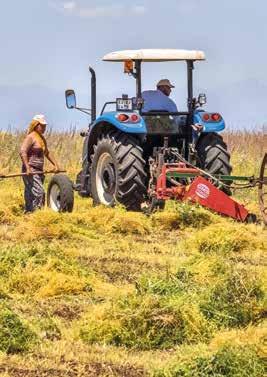
Dan Agro Products, a food supply company in Kyrgyzstan, is a fully owned subsidiary of Bashan Tarimsal Urunleri, a leading international producer of legumes,
grains and oily seeds based in Türkiye. Among other produce, Dan Agro supplies packaged legumes, such as beans, lentils and peas (EBRD, 2021[15]; EBRD, 2023[16]).


Improving self-sufficiency of food, while meeting global safety standards
Dan Agro’s business has created a market for local farmers to produce lentils in Kyrgyzstan. Traditionally, the country has imported lentils from neighbours such as Kazakhstan. Local production of lentils driven by Dan Agro therefore contributes to food security in Kyrgyzstan by reducing reliance on imported agricultural goods. This project helps to address a problem of hidden hunger and undernutrition that remain severe among residents in low-income settings in Kyrgyzstan, especially women (Otunchieva, Smanalieva and Ploeger, 2022[17]).
Dan Agro has provided purchase guarantees to lentil producers, which has encouraged more than 2 000 local farmers to grow lentils. The company’s operation meets the ISO22000 food safety management standard. Business consultancy services helped improve accounting; management of inventory systems; development and implementation of a food safety management system in accordance with Hazard Analysis and Critical Control Point (HACCP) and ISO 22000; and monitoring and valuation of inventory and finished products. Following the success of this initiative, the company now supplies lentils to the World Food Programme.
10 | CLIMATE-RESILIENT AGRIBUSINESS IN CENTRAL ASIA
CONCRETE EXAMPLES
Contributing to climate resilience and GHG reductions
Lentils require considerably less water to grow, which helps build the resilience to greater water stress in a changing climate in Kyrgyzstan, given its semi-arid, relatively cold climate that is also prone to drought (Wojcicka-Swiderska, 2021[18]; Babayeva, S., et al., 2014[19]). Lentil production is also benefitial to crop rotation , since lentils leave more water in the soil for the rotation crops.
Lentils improve soil fertility by fixing nitrogen in the soil and enhancing soil productivity. Lentils also require few synthetic nitrogen fertilisers based on fossil fuels (Nategh
et al., 2021[20]). This leads to lower GHG emissions from manufacture, transport and use of synthetic fertilisers. Further, less use of synthetic fertilisers mitigates the financial burden of their purchase on farmers. Building on this practice, the EBRD is also launching a project with Dan Agro and other partners to support development of lentil and chickpea varieties that are even more resilient to climate risks in the Kyrgyz context.
Revitalising sugar production that also contributes to water and food security and economic diversification in rural communities
Kaindy-Kant is a leading sugar producer in Kyrgyzstan. Established in 1963, the company operates two plants that process sugar beet and sugar cane. The company also runs a network of sugar beet collection points in the Chüy region and cooperates closely with farmers.
Revitalising local sugar beet production and creating employment

Once known as the sugar beet basket of Central Asia, Kyrgyzstan’s sugar production declined substantially after the collapse of the Soviet Union. The EBRD loan to Kaindy-Kant, channelled to working capital financing, was used by Kaindy-Kant to buy sugar beet from local farmers. This project led to a revival of sugar beet cultivation in the Chüy region, with regional production increasing approximately sevenfold between 2012 and
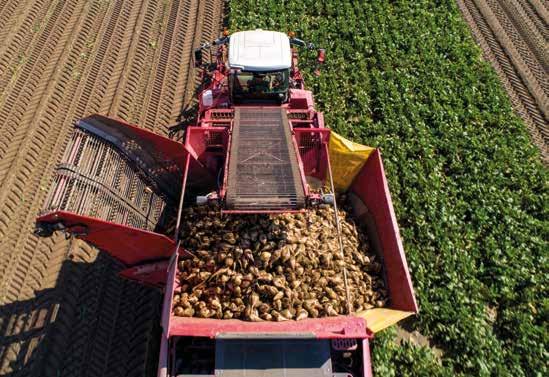
CLIMATE-RESILIENT AGRIBUSINESS IN CENTRAL ASIA | 11
CONCRETE EXAMPLES
Lentils improve soil fertility by fixing nitrogen in the soil and enhancing soil productivity. With this effect, lentils also require few synthetic nitrogen fertilisers based on fossil fuels This leads to lower GHG emissions from manufacture, transport and use of synthetic fertilisers.
2017. (EBRD, 2017[21]). The current supply of sugar beet by more than 3 500 local farmers can also be considered a significant contribution to the government’s priority to integrate small-scale farmers into agri-food value chains (Government of Kyrgyzstan, 2021[22]).

The increase in sugar beet production has also helped diversify the local economy. The project aimed to increase production of sugar beet, and sugar. Sugar production adds value to the crop, higher skilled work and more sophisticated processing plants. Today, Kaindy-Kant is the leading sugar beet processing company in the country and supplies up to 90% of Kyrgyzstan’s demand for sugar. All produced sugar is sold locally at competitive prices, especially given high transportation costs for imported sugar.
Increasing economy resilience of local farmers by growing sugar beet that is resilient to climate risks
Sugar beet production strengthen climate change resilience and water security of farmers in the Chüy region since its growth demands relatively low water compared to many other crop types. This is especially important considering the low water availability and dry climatic conditions in the Chüy region. Kyrgyzstan’s agriculture sector is becoming increasingly sensitive to drought-related risks augmented by climatic change (WFP, 2021[23]). Sugar beet is a crop type that is relatively resilient to certain projected impacts of climate change. One such risk is droughts that are expected to increase in the Chüy region (World Bank, 2019[24]). The choices of crop types to be grown on a given land do not only consider the resilience of the crop, but also its contributions to other factors such as job creation, economic development, food security and prevention of soil depletion.
Providing risk-sharing financial instruments to build confidence from lenders
The EBRD together with the Kyrgyz Investment and Credit Bank (KICB), a leading commercial bank, provided Kaindy-Kant with a risk-sharing financial instrument and working capital loans dedicated to small and mediumsized enterprises. Through the first-loss guarantee under the EU-EBRD SME Finance Facility for Central Asia, KICB would be compensated if the borrower defaults (EBRD, 2017[25]). Similar to the example in Turkmenistan, the EBRD also connected Kaindy-Kant with local management consultants to help the company develop a business plan and draft financial statements in compliance with international standards.
Promoting access to finance for agribusinesses with nexus benefits
Access to finance is often among the greatest challenges to building agribusiness companies’ resilience to climate risks in Central Asia. Financial solutions that blend flexible grant mechanisms with credits and investments can address bottlenecks in investment in agriculture value chains (SAFIN, 2021[26]). In Tajikistan, local financial institutions, the EBRD and other development cooperation partners have been helping agribusinesses access financial solutions with potential benefits for energy, water and food security, and climate risk management.
Providing financial solutions and technical assistance in support of nexus approaches
In Tajikistan, the Green Economy Financing Facility (GEFF) programme provides finance, technical assistance and investment incentives to the private sector to help the country transition to a green economy. GEFF Tajikistan is a product of the EBRD, working in cooperation with the Green Climate Fund, Korea and the European Union. The Facility operates through participating financial institutions in Tajikistan, with USD 25 million of financing for energy
12 | CLIMATE-RESILIENT AGRIBUSINESS IN CENTRAL ASIA
CONCRETE EXAMPLES
and resource efficiency investments. This programme builds on the successes and lessons learnt of earlier EBRD initiatives, including the EBRD Climate Resilience Financing Facility (CLIMADAPT) and the EUfunded Enhanced Competitiveness of Tajik Agribusiness Project (ECTAP).
Through the EBRD and local financial institutions, ECTAP has supported agribusinesses in Tajikistan in several ways. ECTAP has led to an increase of selected crop and livestock yields by 25%, while helping agribusiness companies identify resourceefficient and climate-resilient technologies (Frankfurt School, 2019[27]; EBRD, n.d.[28]). For example, the programme supported pilot projects and capacity development for approximately 1 700 farmers, extension service providers and veterinarians. It also provided technical assistance to about 630 employees of Tajik financial institutions, which provided loans to farmers and agribusinesses. About 50 agriculture suppliers received support for business development, including suppliers of agricultural machinery, poultry equipment, processing and other postharvest equipment, feed equipment and pedigree cattle.
Each of the five Central Asian countries will experience stronger water stress by 2050, due to various factors such as their heavy reliance on seasonal water availability for irrigation and the lower adaptive capacities to manage climate risks.
made available to local financial institutions and their clients, enabling borrowers to select appropriate technologies for their business operation and environmental priorities. When particular technologies are not listed, CLIMADAPT provided climate resilience assessments for the technologies against the same criteria.
Raising awareness about technologies in support of climate resilience and engagement with local financing institutions
CLIMADAPT also organised technology demonstration workshops to strengthen understanding and awareness of available technologies among potential borrowers. An evaluation of CLIMADAPT found a positive correlation between attendance at the workshops and awareness and understanding of issues related to climate resilience. This included the need for improvements to farm buildings and resilience to low and erratic rainfall, as well as other types of climate variability (EBRD, 2020[29]). The evaluation concluded that local financial institutions were effective at promoting loan products for technologies in support of climate resilience. However, it also noted that limited knowledge among farmers about such technologies remained a challenge for financial institutions to increase uptake of loans. For those who did not attend the technology workshops, the primary selling point of CLIMADAPT was economic and social well-being benefits such as business expansion, greater profitability and better living conditions, among others (EBRD, 2020[29]).
CLIMADAPT aimed to support investments in technologies promoting efficient use of water, energy and land resources to address physical climate-related risks such as droughts and erratic rainfall in Tajikistan. CLIMADAPT was implemented by the EBRD, the Climate Investment Funds and the United Kingdom in partnership with local financial institutions. The EBRD identified a range of technologies based on the criteria for water and energy efficiency and sustainable land management. The list of pre-approved technologies was
CLIMADAPT has also generated valuable lessons. For instance, even with the lower-than-market interest rates offered by the programme, half of commercial and residential borrowers thought the rates were too high for them to buy equipment for climate change adaptation variability (EBRD, 2020[29]). Many borrowers also found it challenging to secure enough assets to meet collateral requirements set by local banks. A notable gender gap in accessing finance was also observed. For instance, more than 20% of residential female borrowers reported that collateral requirements were not accessible, while only 7.6% of men reported this challenge (EBRD, 2020[29]). This gap suggests that women tend to lack property titles of assets that could be used as collateral to take loans (EBRD, 2020[29]).
CLIMATE-RESILIENT AGRIBUSINESS IN CENTRAL ASIA | 13
CONCRETE EXAMPLES
Even with the lower-than-market interest rates offered by the programme, half of commercial and residential borrowers thought the rates were too high for them to buy equipment for climate change adaptation variability
Opportunities for scalingup and replication: Evidence, financial
Collect and gather evidence on multi-sectoral benefits of tested nexus solutions, and tailor and communicate it to potential beneficiaries
Identification and quantification of benefits for multiple domains (water, energy and land use) is more challenging than for a single focus area. It is also often not straightforward to account for such multi-sectoral benefits in a project proposal (OECD, 2018[30]). Further, quantifying certain benefits (e.g. avoided loss of biodiversity from the impacts of climate change or pollution) is more challenging than measuring other benefits such as cost saving from greater water and energy efficiency.
These challenges often make it harder to set an appropriate benchmark performance based on costbenefit profiles of certain on-farm technologies and related solutions. Stakeholder consultations for this study revealed that, in Central Asia, agribusinesses often consider techniques and equipment from the Soviet era as the benchmark. Against this benchmark, even 20-year-old technology – often available second-hand and therefore more affordable – can significantly improve efficiency and environmental performance. This makes these technologies financially more attractive than more cutting-edge farming technologies. The latter may have greater and wider economic, environmental and resource-saving benefits, but they require greater initial investment (e.g. strawberry greenhouse in Turkmenistan).
companies with nexus benefits
It is encouraging to see concrete examples of agribusiness companies with multi-sectoral benefits for water, energy and food security, as well as environmental sustainability in Central Asia. Yet, several challenges must be addressed before these “pioneer” business models can be scaled up and replicated within and beyond a particular country. These include barriers related to access to information on available technological and financial solutions that can support nexus approaches, and institutional and individual capacity. The following section highlights some of these barriers to further scaling up and replicating nexus-focused agribusiness investment in Central Asia. Effective solutions for such barriers will be further explored in the project, Water Energy Land-use Linkages: Nexus Solutions for Climate Resilient Central Asia.

As a first step, more evidence is needed on multi-faceted benefits of different nexus approaches for energy, water and land-use management specific to the agriculture sector in Central Asia. Subsequently, communication approaches related to these benefits should target users and their partners (e.g. financial institutions, agriculture extensions) to demonstrate their impact.
The EBRD’s experience has shown that convincing the adoption of good practices requires a significant amount of time, even when their nexus benefits have been identified and assessed. The need to raise awareness on the value of innovative practices has often required EBRD bankers to visit remote regions to demonstrate technical solutions available to agribusiness companies. An experience of such visits in Kyrgyzstan highlighted the importance of communicating messages beyond economic and environmental benefits. Additional messages, for example, could address the health and well-being of children and youth.
14 | CLIMATE-RESILIENT AGRIBUSINESS IN CENTRAL ASIA
solutions and capacity all need to be enhanced to further support good practices of agribusiness
In other cases, information about an agricultural technique with solid economic and nexus-related benefits can be disseminated through existing business channels, such as agribusiness associations. Building on such channels could help disseminate information on benefits of the nexus approaches within the sector and a geographical area. When such communication channels exist, projects can draw on several effective approaches to scale up nexus-oriented agribusinesses. These include finding champions and showing local banks how their business models work; educating entrepreneurs; and sharing lessons with the government to encourage policy reforms that can unlock public and private sector finance. Hilli Gaplama Group organised the “Science Day” programme. It aims to engage local farmers in discussion on how to improve their business productivity and expand distribution channels of their products. Cross-regional peer-learning exercise could also support transboundary knowledge transfer about good practices with a nexus focus.
Apply suitable financial solutions in support of agribusinesses with nexus benefits
Domestic public budgets remain a critical source of finance for development of the agriculture sector. At the same time, the region has also seen an increasing use of blended finance in Central Asia which aims to incentivise agribusiness companies and local financial institutions to engage in the nexus approach through financial contributions from donors and development finance institutions. The EBRD and the European Union, for example, have provided entrepreneurs and other agribusinesses with various financial solutions, as shown in the previous section. Examples include grants for technical assistance, first-loss guarantee for risk mitigation, and concessional loans to finance capital and operational costs in Central Asia. Blended finance can also address some of the factors underlying both real and perceived investment risks for agribusiness; increase the familiarity and comfort with the sector among financial institutions; and develop a track record for both banks and agribusiness companies (OECD, 2021[31])

CLIMATE-RESILIENT AGRIBUSINESS IN CENTRAL ASIA | 15
OPPORTUNITIES FOR SCALING-UP AND REPLICATION
More evidence is needed on multi-faceted benefits of different nexus approaches for energy, water, and land-use management specific to the agriculture sector in Central Asia.
To exploit scaling-up and replication potential of such agribusinesses, farmers still need more education about available financial solutions. It is also important to generate evidence and financial track records of such nexus-oriented agribusinesses and disseminate them to both potential agriculture sector entities and financial institutions. Lessons learnt also include the critical importance of grant funding for, among others, providing business consultancy services to fill certain capacity gaps faced by the banks’ clients.
Provide technical assistance for strengthening technical and business-related capacity in support of the nexus
The need to enhance capacity of agribusinesses in appraising and applying energy, water and land-use nexus approaches in Central Asia can span wide areas. Focus areas of further capacity development can include basic business management (e.g. financial reporting, business planning), identification and
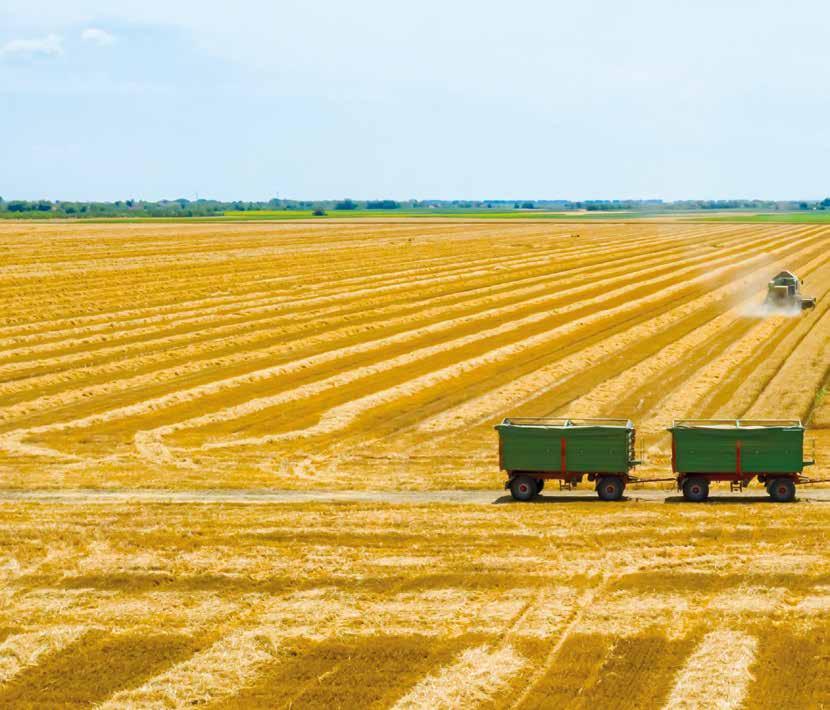
appraisal of relevant technologies and techniques, and development of project proposals. Technical assistance to enhance such capacity may be needed in different phases of project development. For example, a good understanding of climate- and environment-related risks and options for managing them can be essential for drafting project proposals. The ability to compare options based on their costs and benefits is also another important step in selecting technologies. Certain skill sets are also required for installing the chosen solutions, maintaining them, monitoring performance and preparing financial reporting.
In supporting those different types of capacity development, grants from development cooperation partners or Central Asian governments themselves play an important role. While such grants do exist in the region, they still cannot cover all the potential capacity development needs for replicating the nexus-oriented agribusiness at scale across the region. Peer-to-peer learning is needed among, for example, agribusiness
16 | CLIMATE-RESILIENT AGRIBUSINESS IN CENTRAL ASIA
OPPORTUNITIES FOR SCALING-UP AND REPLICATION
owners, agriculture extension services and local financial institutions.
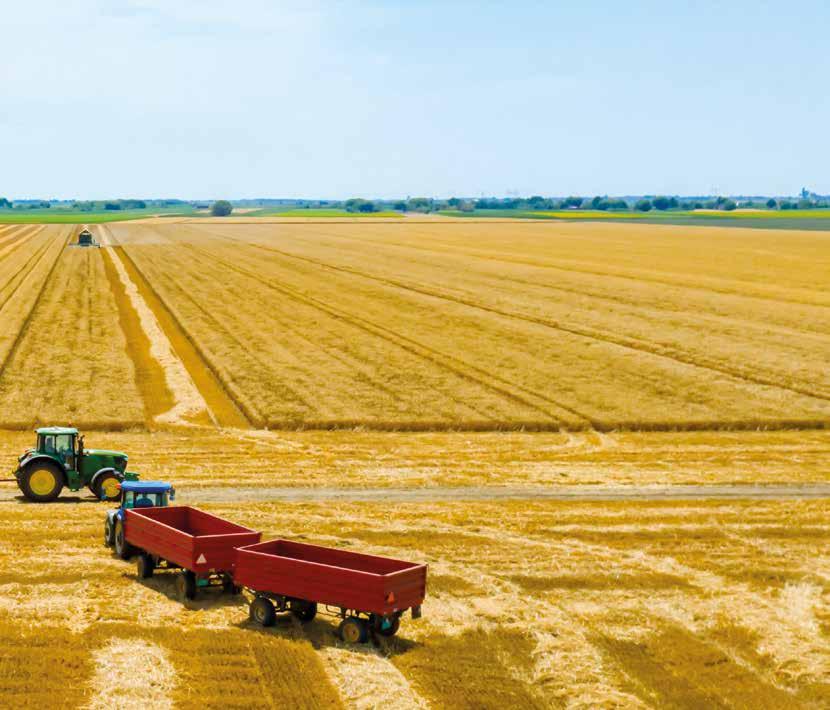
As mentioned in the example in Turkmenistan, the EBRD has collaborated with consultants who can help the bank’s clients develop business plans, integrate environmental and gender considerations into those plans, and develop basic business skills. The availability of such consultants and access to them vary within Central Asia. Efforts to make such consultants available in each of the countries could significantly help facilitate identification, development, replication and scaling-up of agribusinesses with a focus on energy, water and land-use nexus. This model of working with consultants has greatly helped develop the capacity of agribusiness owners. The demand for such support has also grown the market of business consulting in Turkmenistan. Nevertheless, the experience in Turkmenistan also suggests that developing such a network of consultancies can be time and resource intensive.
OPPORTUNITIES FOR SCALING-UP AND REPLICATION
Further, technical services that are highly specialised in water, energy and land resource management often do not exist within the Central Asia region. These include “frontier technologies” listed on EU Best Available Techniques reference documents1. In these cases, external expertise is often needed. This is an area where development co-operation partners can greatly contribute. It is important to facilitate communication and exchange of know-how among interested business owners and experts to ensure the country retains expertise after the support ends.
Endnotes:
1. See project descriptions here: https://issuu.com/oecd.publishing/docs/nexus_project_summary4pgs-final/2
2. Kazakhstan, the Kyrgyz Republic, Tajikistan, Turkmenistan and Uzbekistan.
3. The 2022 Joint Statement of the Consultative Meeting of the Heads of Central Asia States.
4. See also https://eippcb.jrc.ec.europa.eu/reference
CLIMATE-RESILIENT AGRIBUSINESS IN CENTRAL ASIA | 17
References
Babayeva, S., et al. (2014), “Genetic diversity for drought tolerance in lentils from Central Asia and the Caucasus”, https://www.genres.az/uploads/files/BABAYEVA_et_al__2014.pdf
Botta, E., M. Griffiths and T. Kato (2022), “Benefits of regional co-operation on the energy-water-land use nexus transformation in Central Asia”, OECD Green Growth Papers, No. 2022/01, OECD Publishing, Paris, https://doi. org/10.1787/7fcec36c-en.
EBRD (2023), Improving food security in the Kyrgyz Republic, European Bank for Reconstruction and Development (EBRD), https://www.ebrd.com/news/video/improving-food-security-in-the-kyrgyz-republic.html (accessed on 5 April 2023).
EBRD (2021), DFF - Hilli Gaplama, EBRD project webpage, https://www.ebrd.com/work-with-us/projects/psd/51477.html (accessed on 5 April 2023).
EBRD (2021), EBRD and DemirBank promote food security in Kyrgyz Republic, EBRD, https://www.ebrd.com/news/2021/ebrd-and-demirbank-promote-food-security-in-kyrgyz-republic.html.
EBRD (2020), Final Report: Building an evidence base on how private sector investments support gender-sensitive, climate resilient development: The case of Tajikistan, https://cif.org/sites/cif_enc/files/knowledge-documents/private_sector_investment_support_to_gender_ sensitive_development_tajikistan.pdf (accessed on 5 April 2023).
EBRD (2017), EBRD and Kyrgyz Investment and Credit Bank support sugar producer Kaindy-Kant, https://www.ebrd.com/news/2017/ebrd-and-kyrgyz-investment-and-credit-bank-support-sugar-producerkaindykant.html (accessed on 5 April 2023).
EBRD (2017), EBRD Small Business Initiative Newsletter January-December 2017, Issue 25, http://donors.kg/images/EBRD_Small_Business_Initiative_Newsletter_eng.pdf.
EBRD (n.d.), GEFF Tajikistan [Agricultural Value Chains], https://ebrdgeff.com/tajikistan-agri/ (accessed on 5 April 2023).
Frankfurt School (2019), Project overview: ECTAP, https://www.frankfurt-school.de/en/home/international-advisory-services/region/turkey-cca/ectap (accessed on 5 April 2023).
Government of Kyrgyzstan (2021), Kyrgyz Republic Global Agriculture and Food Security Program (GAFSP) Proposal “Strengthening Producer Organizations in Kyrgyz Republic”, https://www.gafspfund.org/sites/default/files/inline-files/5.%20KYRGYZ%20REPUBLIC_GAFSP%20proposal.pdf
Government of Turkmenistan (2022), Nationally Determined Contribution of Turkmenistan under the Paris Agreement, https://unfccc.int/sites/default/files/NDC/2023-01/NDC_Turkmenistan_12-05-2022_approv.%20by%20 Decree_Eng.pdf.
Hamidov, A., K. Helming and D. Balla (2016), “Impact of agricultural land use in Central Asia: a review”, Agronomy for Sustainable Development, Vol. 36/1, pp. 1-23, https://doi.org/10.1007/S13593-015-0337-7/FIGURES/6
IEA (2020), Turkmenistan - Countries & Regions, https://www.iea.org/countries/turkmenistan (accessed on 5 April 2023).
IPCC (2021), Summary for Policymakers. In: Climate Change 2021: The Physical Science Basis. Contribution of Working Group I to the Sixth Assessment Report of the Intergovernmental Panel on Climate Change, The Intergovernmental Panel on Climate Change (IPCC), https://doi.org/10.1017/9781009157896.001.
18 | CLIMATE-RESILIENT AGRIBUSINESS IN CENTRAL ASIA
[19]
[6]
[16]
[9]
[15]
[29]
[21]
[25]
[28]
[27]
[22]
[10]
[12]
[14]
[5]
Liu, W., L. Liu and J. Gao (2020), “Adapting to climate change: gaps and strategies for Central Asia”, Mitigation and Adaptation Strategies for Global Change, Vol. 25/8, pp. 1439-1459, https://doi.org/10.1007/s11027-020-09929-y.
Liu, Y. et al. (2021), “A review of water pollution arising from agriculture and mining activities in Central Asia: Facts, causes and effects”, Environmental Pollution, Vol. 291, p. 118209, https://doi.org/10.1016/J.ENVPOL.2021.118209
Nategh, N. et al. (2021), “Sustainability assessment and optimization of legumes production systems: energy, greenhouse gas emission and ecological footprint analysis”, Renewable Agriculture and Food Systems, Vol. 36/6, pp. 576-586, https://doi.org/10.1017/S1742170521000193.
OECD (2021), Good blended finance practices can scale up finance for agri-SMEs”, OECD Development Co-operation Directorate, https://oe.cd/fsd-dac (accessed on 5 April 2023).
OECD (2018), Strengthening Shardara Multi-Purpose Water Infrastructure in Kazakhstan, OECD Studies on Water, OECD Publishing, Paris, https://doi.org/10.1787/9789264289628-en
Otunchieva, A., J. Smanalieva and A. Ploeger (2022), “Dietary Quality of Women of Reproductive Age in LowIncome Settings: A Cross-Sectional Study in Kyrgyzstan”, Nutrients, Vol. 14/2, p. 289, https://doi.org/10.3390/NU14020289/S1
Pereira Ramos, E. et al. (2021), “The climate, land, energy, and water systems (CLEWs) framework: a retrospective of activities and advances to 2019”, Environ. Res. Lett, Vol. 16, p. 33003, https://doi.org/10.1088/1748-9326/abd34f.
Ronay, K. and C. Dumitru (2015), “Hydroponic Greenhouse Energy Supply Based on Renewable Energy Sources”, Procedia Technology, Vol. 19, pp. 703-707, https://doi.org/10.1016/J.PROTCY.2015.02.099
SAFIN (2021), Deploying Blended Finance to Mobilize Investment at Scale in Food and Agriculture, https://www.safinetwork.org/safinresources/Blended-finance-for-agriculture
SIC ICWC & OECD (2021), The use and management of water resources in Central Asia, https://issuu.com/oecd.publishing/docs/central_asia_water_management-web (accessed on 5 April 2023).
Umirbekov, A., A. Akhmetov and Z. Gafurov (2022), Water–agriculture–energy nexus in Central Asia through the lens of climate change, CAREC Institute, http://www.carecinstitute.org/.
UNECE (2021), Solutions and investments in the water-food-energy-ecosystems nexus: A synthesis of experiences in transboundary basins, United Nations Economic Commission for Europe, Geneva.
WFP (2021), Abnormal dryness conditions and lower amount of irrigation water impact on food security in the Kyrgyz Republic - Kyrgyzstan | ReliefWeb, World Food Programme (WFP), https://reliefweb.int/attachments/704a958f-8309-38c6-b555-bf7f71c75ff7/WFP-0000130812.pdf (accessed on 5 April 2023).
Wojcicka-Swiderska, K. (2021), Lentils: A low-carbon, climate-smart crop, https://insights.figlobal.com/pulse-canada/lentils-low-carbon-climate-smart-crop-interview (accessed on 5 April 2023).
World Bank (2022), World Development Indicators, https://datatopics.worldbank.org/world-development-indicators/ (accessed on 5 September 2022).
World Bank (2019), Climate-smart agriculture for Kyrgyz Republic, CSA Country Profiles for Asia Series. International Center for Tropical Agriculture (CIAT); World Bank, Washington, D.C. 28 p., https://climateknowledgeportal.worldbank.org/sites/default/files/2019-03/CSA%20_Profile_The%20 Kyrgyz%20Republic.pdf (accessed on 5 April 2023).
CLIMATE-RESILIENT AGRIBUSINESS IN CENTRAL ASIA | 19
[4]
[11]
[20]
[31]
[30]
[17]
[8]
[13]
[26]
[2]
[3]
[7]
[23]
[18]
[1]
[24] REFERENCES
